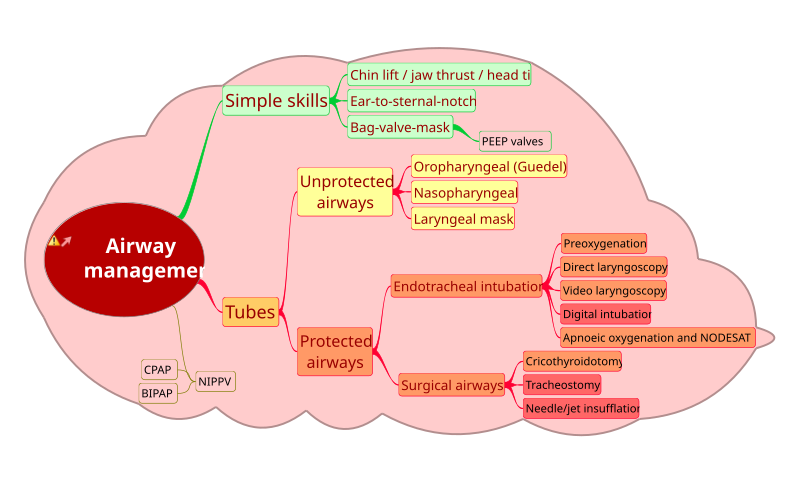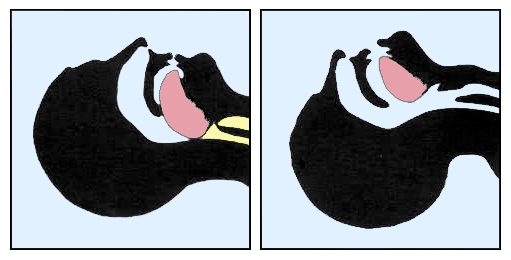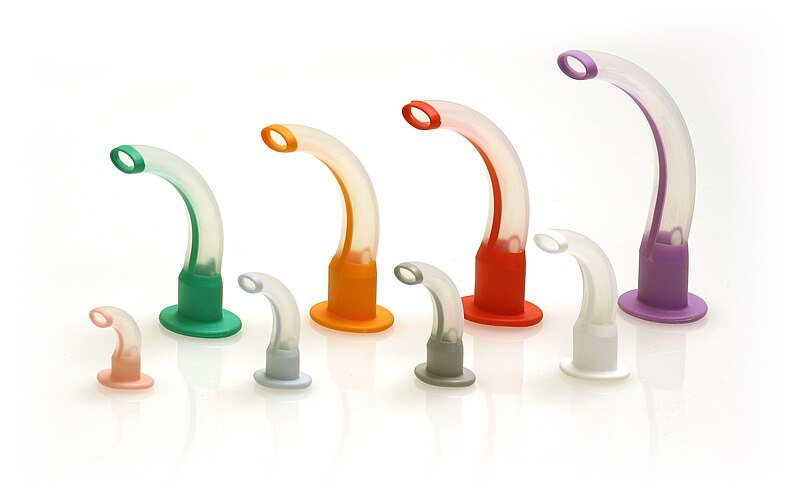Airway management are a set of medical procedures preformed in order to prevent airway obstruction and thus ensuring an open pathway between a patient’s lungs and the outside world. This is accomplished by clearing or preventing obstructions of airways, often referred to as choking, caused by the tongue, the airways themselves, foreign bodies or materials from the body itself, such as blood or stomach content, the latter resulting in aspiration.
Airway management can be divided into two categories: Basic and advanced airway management. Basic techniques are simple to perform even by non-health care professionals and do not require use of medical equipment, whereas advanced techniques require special training and medical equipment. Advanced airway management is further categorised in increasing order of invasiveness into supraglottic devices, such as oropharyngeal or nasopharyngeal airways, followed by infraglottic techniques, such as tracheal intubation, and finally surgical methods.
Airway management is a primary consideration in cardiopulmonary resuscitation, anaesthesia, emergency medicine, intensive care medicine and first aid. Airway management is covered under "A" In the ABC treatment mnemonic.
Basic airway management

Basic airway management is mainly used in first aid since it is non-invasive, simple to performe and unlike advanced airway management does not relies on the use of medical equipment. Basic airways management can be divided into treatment and prevention.
Treatment
Treatment includes a number of procedures aiming at removing foreign bodies from the airways. Most modern protocols, including those of the American Heart Association, American Red Cross and the European Resuscitation Council, recommend several stages, designed to apply increasingly more pressure. Basic treatment treatment includes a number of procedures aiming at removing foreign bodies from the airways. Most protocols recommend encouraging the victim to cough, followed by hard back slaps and if none of these things work; abdominal thrusts (Heimlich maneuver) or chest thrusts. Some guidelines recommend alternating between abdominal thrusts and back slaps.
The American Medical Association advocates sweeping the fingers across the back of the throat to attempt to dislodge airway obstructions, once the choking victim becomes unconscious. However, many modern protocols recommend against the use of the finger sweep since, if the patient is conscious, they will be able to remove the foreign object themselves, or if they are unconscious, the rescuer should simply place them in the recovery position as this allows (to a certain extent) the drainage of fluids out of the mouth instead of down the trachea due to gravity. There is also a risk of causing further damage (for instance inducing vomiting) by using a finger sweep technique.
Prevention
Prevention techniques focuses on preventing the tongue from falling back and obstructing the airways, such as head-tilt/chin-lift and jaw-thrust maneuvers, while use of the recovery position mainly prevents aspiration of things like stomach content or blood. If head-tilt chin-lift and jaw-thrust maneuvers are performed with any objects in the airways it may dislodge them further down the airways and thereby cause more blockage and harder removal.
The head-tilt/chin-lift is the primary maneuver used in any patient in whom cervical spine injury is not a concern. The simplest way of ensuring an open airway in an unconscious patient is to use a head-tilt/chin-lift technique, thereby lifting the tongue from the back of the throat. This is taught on most first aid courses as the standard way of clearing an airway.
The jaw-thrust maneuver is an effective airway technique, particularly in the patient in whom cervical spine injury is a concern. The jaw thrust is a technique used on patients with a suspected spinal injury and is used on a supine patient. The practitioner uses their index and middle fingers to physically push the posterior (back) aspects of the mandible upwards while their thumbs push down on the chin to open the mouth. When the mandible is displaced forward, it pulls the tongue forward and prevents it from occluding the entrance to the trachea.
The recovery position refers to one of a series of variations on a lateral recumbent or three-quarters prone position of the body, in to which an unconscious but breathing casualty can be placed. Use of the recovery position prevents aspiration.
Most airway maneuvers are associated with some movement of the cervical spine. Even though collars for holding the head in-line can cause problems maintaining an airway and maintaining a blood pressure, it is unrecommended to remove the collar without adequate personnel to manually hold the head in place.
Advanced airway management

Unlike basic airway management such as head-tilt or jaw-thrust maneuver, advanced airway management relies on the use of medical equipment. Advanced airway management can be performed "blind" or with visualization of the glottis e.g. by the use of a laryngoscope. It is frequently performed in critically injured, ill or anesthetized patients to facilitate ventilation of the lungs, including mechanical ventilation, and to prevent the possibility of asphyxiation or airway obstruction.
In roughly increasing order of invasiveness are the use of supraglottic devices such as oropharyngeal or nasopharyngeal airways, followed by infraglottic techniques such as tracheal intubation and finally surgical methods.
Removal of foreign objects
In advanced airway management foreign objects are either removed by suction or with e.g. a Magill forceps under inspection of the airway with a laryngoscope or bronchoscope. If removal is not possible surgical methods should be considered.
Supraglottic techniques
Supraglottic techniques includes the use of supraglottic tubes, such as oropharyngeal (OPA) and Nasopharyngeal airways (NPA), and supraglottic devises such as laryngeal masks. Common for all supraglottic devises are that the are introduced into the pharynx, ensuring the upper respiratory tract remains open, without passing through the glottis and thereby entering the trachea.
Nasopharyngeal airways is a soft rubber or plastic hollow tube that is passed through the nose into the posterior pharynx. Patients tolerate NPAs more easily than OPAs, so NPAs can be used when the use of an OPA is difficult, such as when the patient's jaw is clenched or the patient is semiconscious and cannot tolerate an OPA. NPAs are generally not recommended if there is suspicion of a fracture to the base of the skull, due to the possibility of the tube entering the cranium. However, the actual risks of this complication occurring compared to the risks of damage from hypoxia if an airway is not used are debatable.
Oropharyngeal airways are rigid plastic curved devices, which are inserted trough the patients mouth. It prevents the patients tongue from covering the epiglottis and thereby obstructing the airway. An oropharyngeal airway should only be used in a deeply unresponsive patient because in a responsive patient they can cause vomiting and aspiration by stimulating the gag reflex.
Supraglottic airways (or extraglottic devices) are a family of devices that are inserted through the mouth to sit on top of the larynx. Supraglottic airways are used in the majority of operations performed under general anaesthesia. Compared to a cuffed tracheal tube (see below), they give less protection against aspiration but are easier to insert and cause less laryngeal trauma. The best-known example is the Laryngeal Mask Airway or LMAâ„¢. A laryngeal mask airway is an airway placed into the mouth and set over the glottis and inflated. Other variations include devices with oesophageal access ports, so that a separate tube can be inserted from the mouth to the stomach to decompress accumulated gases and drain liquid contents. Some devices can have an endotracheal tube passed through them into the trachea.
Infraaglottic techniques
Unlike supraglottic devices; infraglottic devices pass through the glottis and thereby enter the trachea. Tracheal intubation, often simply referred to as intubation, is the placement of a flexible plastic or rubber tube into the trachea to maintain an open airway or to serve as a conduit through which to administer certain drugs. The most widely used route is orotracheal, in which an endotracheal tube is passed through the mouth and vocal apparatus into the trachea. In a nasotracheal procedure, an endotracheal tube is passed through the nose and vocal apparatus into the trachea.
Alternatives to standard endotracheal tubes includes laryngeal tube and combitube.
Surgical methods
Surgical methods for airway management rely on making a surgical incision is made below the glottis in order to achieve direct access to the lower respiratory tract, bypassing the upper respiratory tract. Surgical airway management is often performed as a last resort in cases where orotracheal and nasotracheal intubation are impossible or contraindicated. Surgical airway management is also used when a person will need a mechanical ventilator for a longer period. Surgical methods for airway management include cricothyrotomy and tracheostomy.
A cricothyrotomy is an incision made through the skin and cricothyroid membrane to establish a patent airway during certain life-threatening situations, such as airway obstruction by a foreign body, angioedema, or massive facial trauma. A cricothyrotomy is nearly always performed as a last resort in cases where orotracheal and nasotracheal intubation are impossible or contraindicated. Cricothyrotomy is easier and quicker to perform than tracheotomy, does not require manipulation of the cervical spine and is associated with fewer complications.
A tracheotomy is a surgically created opening from the skin of the neck down to the trachea. A tracheotomy may be considered where a person will need to be on a mechanical ventilator for a longer periode. The advantages of a tracheotomy include less risk of infection and damage to the trachea such as tracheal stenosis.
Airway management in specific situations

Cardiopulmonary resuscitation
The best method of airway management during CPR is controversial. There has been less emphasis on airway management (including simple mouth-to-mouth or invasive methods) during CPR, since it was shown that people receiving initial chest-compression-only CPR were more likely to survive than those who had standard CPR. People who are resuscitated with basic bag-mask ventilation may also be more likely to survive than those who are intubated or have a supraglottic airway inserted. However, in children, or where the cause of the arrest was an airway or breathing problem, or where the arrest is prolonged, airway management is still important.
In basic life support, many people can be reluctant to start mouth-to-mouth resuscitation. The American Heart Association now supports "Hands-only"â„¢ CPR, which advocates chest compressions without any airway management for teens or adults. Bystanders who see an adult suddenly collapse should call for help and move to chest compressions straight away. It is likely that later in resuscitation care by trained professionals, simple methods as well as supraglottic and tracheal airways each have a role, depending on the skills of the person performing them and the equipment or environment they are working in.
Trauma
In prehospital environments, airway management is controversial, with intubation and supraglottic airways each having advantages and disadvantages. Trauma victims are often not fasting so there is an increased risk of aspiration, but blood and other material may make it difficult to see the larynx to intubate.
References
- ^ a b Nolan, JP; Soar, J; Zideman, DA; Biarent, D; Bossaert, LL; Deakin, C; Koster, RW; Wyllie, J; Böttiger, B; ERC Guidelines Writing Group. "European Resuscitation Council Guidelines for Resuscitation 2010 Section 1. Executive summary". Resuscitation 81 (10): 1226. doi:10.1016/j.resuscitation.2010.08.021. PMID 20956052. Retrieved 20 December 2014.Â
- ^ American Medical Association (2009-05-05). American Medical Association Handbook of First Aid and Emergency Care. Random House. ISBNÂ 978-1-4000-0712-7.Â
- ^ Donaldson WF, Heil BV, Donaldson VP, Silvaggio VJ (1997). "The effect of airway maneuvers on the unstable C1-C2 segment. A cadaver study.". Spine (Phila Pa 1976) 22 (11): 1215â€"8. doi:10.1097/00007632-199706010-00008. PMID 9201858.Â
- ^ Brimacombe J, Keller C, Künzel KH, Gaber O, Boehler M, Pühringer F (2000). "Cervical spine motion during airway management: a cinefluoroscopic study of the posteriorly destabilized third cervical vertebrae in human cadavers". Anesth Analg 91 (5): 1274â€"8. doi:10.1213/00000539-200011000-00041. PMID 11049921.Â
- ^ Kolb JC, Summers RL, Galli RL (1999). "Cervical collar-induced changes in intracranial pressure". Am J Emerg Med 17 (2): 135â€"7. doi:10.1016/S0735-6757(99)90044-X. PMID 10102310.Â
- ^ Mobbs RJ, Stoodley MA, Fuller J (2002). "Effect of cervical hard collar on intracranial pressure after head injury". ANZ J Surg 72 (6): 389â€"91. doi:10.1046/j.1445-2197.2002.02462.x. PMID 12121154.Â
- ^ Roberts K, Whalley H, Bleetman A (2005). "The nasopharyngeal airway: dispelling myths and establishing the facts". Emerg Med J 22 (6): 394â€"6. doi:10.1136/emj.2004.021402. PMC 1726817. PMID 15911941.Â
- ^ a b Ellis, D. Y. (2006). "Intracranial placement of nasopharyngeal airways: Is it all that rare?". Emergency Medicine Journal 23 (8): 661â€"661. doi:10.1136/emj.2006.036541.Â
- ^ Roberts, K.; Whalley, H.; Bleetman, A. (2005). "The nasopharyngeal airway: Dispelling myths and establishing the facts". Emergency Medicine Journal 22 (6): 394â€"396. doi:10.1136/emj.2004.021402. PMC 1726817. PMID 15911941.Â
- ^ "Guedel airway". AnaesthesiaUK. 14 May 2010. Retrieved 23 May 2013.Â
- ^ a b c d e f Hernandez, MR; Klock, A; Ovassapian, A (2011). "Evolution of the Extraglottic Airway: A Review of Its History, Applications, and Practical Tips for Success". Anesthesia and Analgesia 114 (2): 349â€"68. doi:10.1213/ANE.0b013e31823b6748. PMID 22178627.Â
- ^ Cook, T; Howes, B. (2010). "Supraglottic airway devices: recent advances". Continuing Education in Anaesthesia, Critical Care and Pain 11 (2): 56. doi:10.1093/bjaceaccp/mkq058.Â
- ^ Davies PRF, Tighe SQM, Greenslade GL, Evans GH (1990). "Laryngeal mask airway and tracheal tube insertion by unskilled personnel". The Lancet 336 (8721): 977â€"979. doi:10.1016/0140-6736(90)92429-L. PMID 1978159. Retrieved 25 July 2010.Â
- ^ Mohan, R; Iyer, R; Thaller, S (2009). "Airway management in patients with facial trauma". Journal of Craniofacial Surgery 20 (1): 21â€"3. doi:10.1097/SCS.0b013e318190327a. PMID 19164982.Â
- ^ Katos, MG; Goldenberg, D (2007). "Emergency cricothyrotomy". Operative Techniques in Otolaryngology 18 (2): 110â€"4. doi:10.1016/j.otot.2007.05.002.Â
- ^ a b c Gomes Silva, B. N.; Andriolo, R. G. B.; Saconato, H.; Atallah, Ã. N.; Valente, O. (2012). Gomes Silva, Brenda Nazaré, ed. "Early versus late tracheostomy for critically ill patients". The Cochrane Library. doi:10.1002/14651858.CD007271.pub2.Â
- ^ a b c d e Soar, J.; Nolan, J. P. (2013). "Airway management in cardiopulmonary resuscitation". Current Opinion in Critical Care 19 (3): 181â€"187. doi:10.1097/MCC.0b013e328360ac5e. PMID 23519082.Â
- ^ a b c Sayre, M. R.; Berg, R. A.; Cave, D. M.; Page, R. L.; Potts, J.; White, R. D.; American Heart Association Emergency Cardiovascular Care Committee (2008). "Hands-Only (Compression-Only) Cardiopulmonary Resuscitation: A Call to Action for Bystander Response to Adults Who Experience Out-of-Hospital Sudden Cardiac Arrest: A Science Advisory for the Public from the American Heart Association Emergency Cardiovascular Care Committee". Circulation 117 (16): 2162â€"2167. doi:10.1161/CIRCULATIONAHA.107.189380. PMID 18378619.Â
Further reading
- Daniel Limmer; Keith J. Karren; Brent Q. Hafen; John Mackay; Michelle Mackay (2006). Emergency Medical Responder (Second Canadian Version). Brady. pp. 92â€"97. ISBN 0-13-127824-X.Â




0 komentar :
Posting Komentar